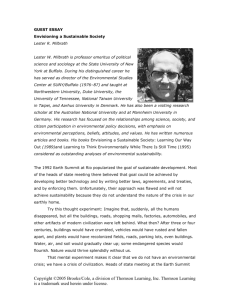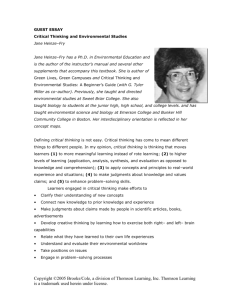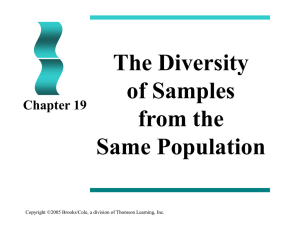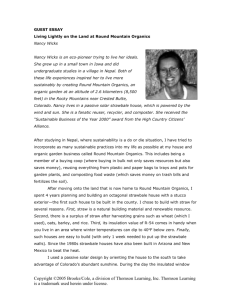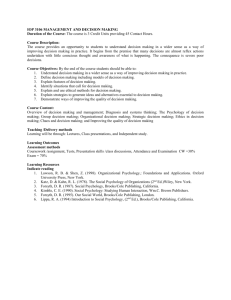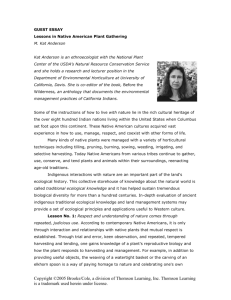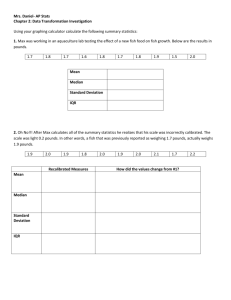Means and and Proportions Proportions as Random as Random
advertisement
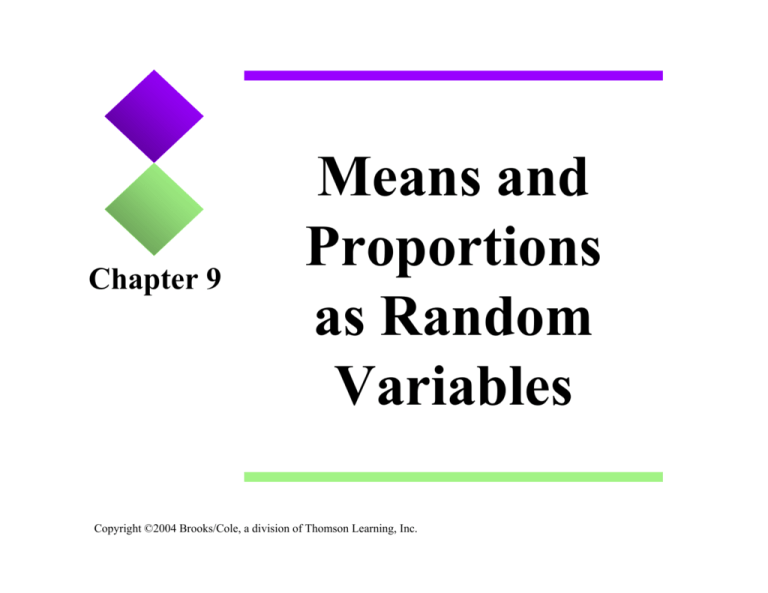
Chapter 9 Means and Proportions as Random Variables Copyright ©2004 Brooks/Cole, a division of Thomson Learning, Inc. 9.1 Understandingg Dissimilarityy Among Samples K Key: Needd to understand d d what h ki kindd off dissimilarity di i il i we should expect to see in various samples from the same population population. • Suppose knew most samples were likely to provide an answer that th t is i within ithi 10% off the th population l ti answer. • Then would also know the population answer should be within 10% of whatever our specific sample gave. gave • => Have a good guess about the population value based on jjust the sample p value. Copyright ©2004 Brooks/Cole, a division of Thomson Learning, Inc. 2 Statistics and Parameters A statistic is a numerical value computed p from a sample. Its value may differ for different samples. e.g. sample mean x , sample standard deviation s, and sample proportion p̂. A parameter is a numerical value associated with a population. Considered fixed and unchanging. e g population mean μ, population standard e.g. deviation σ, and population proportion p. Copyright ©2004 Brooks/Cole, a division of Thomson Learning, Inc. 3 Sampling Distributions Each new sample taken => sample l statistic i i will ill change. h The distribution of possible values of a statistic for repeated samples of the same size from a population is called the sampling distribution of the statistic. Many statistics of interest have sampling distributions that are approximately normal distributions Copyright ©2004 Brooks/Cole, a division of Thomson Learning, Inc. 4 Example 9.1 Mean Hours of Sleep f C for College ll Students St d t Survey of n = 190 college students. “How many hours of sleep did you get last night?” Sample mean = 7.1 hours. If we repeatedly took samples of 190 and each time computed the sample mean, the histogram of the resultingg sample p mean values would look like the histogram at the right: Copyright ©2004 Brooks/Cole, a division of Thomson Learning, Inc. 5 9.2 Sampling p g Distributions for Sample Proportions • Suppose (unknown to us) 40% of a population carry the gene for a disease, (p = 0.40). • We W will ill take t k a random d sample l off 25 people l from f this population and count X = number with gene. • Although we expect (on average) to find 10 people (40%) with the gene, we know the number will vary for different samples of n = 25. • In this case, X is a binomial random variable with n = 25 and p = 0.4. Copyright ©2004 Brooks/Cole, a division of Thomson Learning, Inc. 6 Many Possible Samples Four possible random samples of 25 people: Sample p 1: X =12,, pproportion p with ggene =12/25 = 0.48 or 48%. Sample 2: X = 9, proportion with gene = 9/25 = 0.36 or 36%. Sample 3: X = 10, proportion with gene = 10/25 = 0.40 or 40%. Sample 4: X = 7, proportion with gene = 7/25 = 0.28 or 28%. Note: • Each sample gave a different answer, which did not always y match the population p p value of 40%. • Although we cannot determine whether one sample will accurately reflect the population, statisticians have d t determined i d what h t to t expect for f mostt possible ibl samples. l Copyright ©2004 Brooks/Cole, a division of Thomson Learning, Inc. 7 The Normal Curve Approximation Rule for Sample Proportions L t p = population Let l ti proportion ti off interest i t t or binomial probability of success. p̂ = sample Let p p pproportion p or pproportion p of successes. If numerous random samples or repetitions of the same size n are taken, the distribution of possible values of p̂ is approximately a normal curve distribution with • Mean = p p (1 − p ) p̂ ) = • Standard St d d d deviation i ti = s.d.( d(p n This approximate distribution is sampling distribution of p̂ . Copyright ©2004 Brooks/Cole, a division of Thomson Learning, Inc. 8 The Normal Curve Approximation Rule for Sample Proportions Normal Approximation Rule can be applied in two situations: Situation 1: A random sample is taken from a population. Situation 2: A binomial experiment is repeated numerous times. In each situation, three conditions must be met: Condition 1: The Physical Situation Th is There i an actuall population l i or repeatable bl situation. i i Condition 2: Data Collection A random sample is obtained or situation repeated many times. times Condition 3: The Size of the Sample or Number of Trials The size of the sample p or number of repetitions p is relatively y large, g , np and n(1-p) must be at least 5 and preferably at least 10. Copyright ©2004 Brooks/Cole, a division of Thomson Learning, Inc. 9 Examples for which Rule Applies • Election Polls: to estimate proportion who favor a candidate; units = all voters. voters • Television Ratings: to estimate proportion of households watching TV program; units = all households with TV. • Consumer Preferences: to estimate proportion of consumers who prefer new recipe compared with old; units = all consumers. • Testing ESP: to estimate probability a person can successfully guess which of 5 symbols on a hidden card; repeatable situation = a guess. guess Copyright ©2004 Brooks/Cole, a division of Thomson Learning, Inc. 10 Example 9.2 Possible Sample Proportions F Favoring i a Candidate C did t Suppose 40% all voters favor Candidate X. Pollsters take a sample of n = 2400 voters. voters Rule states the sample proportion who favor X will have approximately a normal distribution with mean = p = 0.4 0 4 and s.d.( s d (p p̂ ) = p (1 − p ) n = 0.4(1 − 0.4) 2400 = 0.01 Histogram at right shows sample proportions resulting from simulatingg this situation 400 times. Copyright ©2004 Brooks/Cole, a division of Thomson Learning, Inc. 11 Estimating the Population Proportion f from a Single Si l Sample S l Proportion P i In practice, we don’t know the true population proportion p, so we cannot compute the standard deviation of p̂ˆ , s.d.( p̂ ) = p (1 − p ) n . In practice, we only take one random sample, so we only have one sample proportion p̂ . Replacing p with p̂ in the standard deviation expression gives us an estimate that is called the standard error of p̂ . s.e.( p̂ ) = pˆ (1 − pˆ ) n . If p̂ = 0.39 and n = 2400, then the standard error is 0.01. So the true proportion who support the candidate is almost surely between 0.39 – 3(0.01) = 0.36 and 0.39 + 3(0.01) = 0.42. Copyright ©2004 Brooks/Cole, a division of Thomson Learning, Inc. 12 9.3 What to Expect p of Sample Means • Suppose we want to estimate the mean weight loss for all who attend clinic for 10 weeks. Suppose (unknown to us) the distribution of weight loss is approximately N(8 pounds, 5 pounds). • We will take a random sample of 25 people from this population and record for each X = weight loss. • We know the value of the sample mean will vary for different samples of n = 25. • What Wh t do d we expectt those th means to t be? b ? Copyright ©2004 Brooks/Cole, a division of Thomson Learning, Inc. 13 Many Possible Samples Four possible random samples of 25 people: Sample 1: Mean = 8.32 8 32 pounds, pounds standard deviation = 4.74 4 74 pounds. pounds Sample 2: Mean = 6.76 pounds, standard deviation = 4.73 pounds. Sample p 3: Mean = 8.48 pounds, p , standard deviation = 5.27 ppounds. Sample 4: Mean = 7.16 pounds, standard deviation = 5.93 pounds. Note: • Each sample gave a different answer, which did not always match the population mean of 8 pounds. • Although we cannot determine whether one sample mean will accurately reflect the population mean, statisticians have determined what to expect for most possible sample means. means Copyright ©2004 Brooks/Cole, a division of Thomson Learning, Inc. 14 The Normal Curve Approximation Rule for Sample Means Lett μ = mean for L f population l ti off interest. i t t Let σ = standard deviation for population of interest. Let x = sample p mean. If numerous random samples of the same size n are taken, the distribution of possible values of x is approximately a normal curve distribution with • Mean = μ σ • Standard St d d d deviation i ti = s.d.( d (x ) = n This approximate distribution is sampling distribution of x . Copyright ©2004 Brooks/Cole, a division of Thomson Learning, Inc. 15 The Normal Curve Approximation Rule for Sample Means N Normal l Approximation A i ti Rule R l can be b applied li d in i two t situations: it ti Situation 1: The population of measurements of interest is bell shaped and a random sample of any size is measured. bell-shaped measured Situation 2: The population of measurements of interest is not bell shaped but a large random sample is measured. bell-shaped measured Note: Difficult to get a Random Sample? Researchers usually willing to use Rule as long as they have a representative sample with no obvious sources of confounding or bias. Copyright ©2004 Brooks/Cole, a division of Thomson Learning, Inc. 16 Examples for which Rule Applies • Average Weight Loss: to estimate average weight loss;; weight g assumed bell-shaped; p ; population p p = all current and potential clients. • Average g Age g At Death: to estimate average g age g at which left-handed adults (over 50) die; ages at death not bell-shaped so need n ≥ 30; population = all left-handed ppeople p who live to be at least 50. • Average Student Income: to estimate mean monthly income of students at universityy who work; incomes not bell-shaped and outliers likely, so need large random sample of students; population = all students at university who work. Copyright ©2004 Brooks/Cole, a division of Thomson Learning, Inc. 17 Example 9.4 Hypothetical Mean W i ht Loss Weight L Suppose the distribution of weight loss is approximately N(8 ( p pounds,, 5 p pounds)) and we will take a random sample p of n = 25 clients. Rule states the sample mean weight loss will have a normal distribution with σ 5 = = 1 pound mean = μ = 8 pounds and s.d.( s d ( x) = n 25 Histogram at right shows sample p means resulting g from simulating this situation 400 times. Empirical E i i l Rule: R l It is almost certain that the sample mean will be b between 5 and d 11 pounds. d Copyright ©2004 Brooks/Cole, a division of Thomson Learning, Inc. 18 Standard Error of the Mean In practice, the population standard deviation σ is rarely known, so we cannot compute the standard deviation of x , σ s.d.( x ) = . n In practice, we only take one random sample, so we only have the sample mean x and the sample standard deviation s. Replacing σ with s in the standard deviation expression gives us an estimate that is called the standard error of x . s s.e.( x ) = . n For a sample of n = 25 weight losses, the standard deviation is s = 4.74 pounds. So the standard error of the mean is 00.948 948 pounds pounds. Copyright ©2004 Brooks/Cole, a division of Thomson Learning, Inc. 19 Increasing the Size of the Sample Suppose we take n = 100 people instead of just 25. The standard deviation of the mean would be s.d.( d (x) = σ n = 5 = 0.5 pounds. d 100 • For samples of n = 25, sample means are likely to range between 8 ± 3 pounds => > 5 to 11 pounds. pounds • For samples of n = 100, sample means are likely to range only l between b t 8 ± 1.5 15 pounds => 6.5 to 9.5 pounds. Larger a ge samples sa ples tend e d too result esu in more o e accurate accu ate es estimates es of population values than smaller samples. Copyright ©2004 Brooks/Cole, a division of Thomson Learning, Inc. 20 Sampling for a Long, Long Time: Th L The Law off L Large N Numbers b LLN: the LLN h sample l mean x will ill eventually ll get “close” to the population mean μ no matter how small a difference you use to define “close close.” LLN = peace off mind i d to casinos, i insurance i companies. i • Eventually, after enough gamblers or customers, the mean net profit will be close to the theoretical mean. mean • Price to pay = must have enough $ on hand to pay the occasional winner or claimant. Copyright ©2004 Brooks/Cole, a division of Thomson Learning, Inc. 21 9.4 What to Expect p in Other Situations: CLT The Central Limit Theorem states that if n is sufficiently large, the sample means of random samples l from f a population l ti with ith mean μ and d finite standard deviation σ are approximately normally distributed with mean μ and standard deviation σ n . Technical T h i l Note: N t The mean and standard deviation given in the CLT hold for any sample size; it is only the “approximately normal” shape that requires n to be sufficiently large. Copyright ©2004 Brooks/Cole, a division of Thomson Learning, Inc. 22 Example 9.5 California Decco Winnings California Decco lottery game: mean amount lost per ticket over millions of tickets sold is μ = $0.35; standard deviation σ = $29.67 $29 67 => > large variability in possible amounts won/lost, from net win of $4999 to net loss of $1. Suppose store sells 100,000 100 000 tickets in a year. year CLT => > distribution of possible sample mean loss per ticket is approximately normal with … mean (loss) = μ = $0.35and s.d.( x) = σ $29.67 = = $0.09 n 100000 Empirical Rule: The mean loss is almost surely between $0.08 and $0.62 => total loss for the 100,000 tickets is likely between $8,000 to $62,000! There are better ways to invest $100,000. Copyright ©2004 Brooks/Cole, a division of Thomson Learning, Inc. 23 9.6 Standardized Statistics If conditions are met, these standardized statistics have, approximately, a standard ( , ) normal distribution N(0,1). Copyright ©2004 Brooks/Cole, a division of Thomson Learning, Inc. 24 Example 9.7 Unpopular TV Shows Networks cancel shows with low ratings. Ratings based on random sample of households, using the sample proportion ti pˆ watching t hi show h as estimate ti t off population l ti proportion p. If p < 0.20, show will be cancelled. Suppose in a random sample of 1600 households, households 288 are watching (for proportion of 288/1600 = 0.18). Is it likely to see pp̂ = 0.18 even if p were 0.20 ((or higher)? g ) z= pˆ − p p( 1− p) n = 0.18 − 0.20 0.20( 1− 0.20 ) 1600 = −2.00 The sample proportion of 0.18 is about 2 standard deviations below the mean of 0.20. 0 20 Copyright ©2004 Brooks/Cole, a division of Thomson Learning, Inc. 25 9.7 Student’s Student s tt-Distribution: Distribution: Replacing σ with s Dil Dilemma: we generally ll don’t d ’t know k σ. Using U i s we have: h x−μ x−μ t= = = s.e.(( x ) s / n n (x − μ) s If the sample p size n is small,, this standardized statistic will not have a N(0,1) distribution but rather a tt-distribution distribution with n – 1 degrees of freedom (df). More on t-distributions and tables of probability areas in Chapters 12-13. Copyright ©2004 Brooks/Cole, a division of Thomson Learning, Inc. 26 Example 9.8 Standardized Mean Weights Claim: mean weight loss is μ = 8 pounds. Sample of n =25 25 people gave a sample mean weight loss of x = 8.32 pounds and a sample standard deviation of s = 4.74 pounds. Is the sample mean of 8.32 pounds reasonable to expect if μ = 8 pounds? t= x −μ s n = 8.32 −8 4.74 25 = 0.34 The sample mean of 8.32 is only about one-third of a standard error above 8, which is consistent with ith a population l ti mean weight i ht loss l off 8 pounds. d Copyright ©2004 Brooks/Cole, a division of Thomson Learning, Inc. 27 9.8 Statistical Inference • Confidence Intervals: uses sample data t provide to id an interval i t l off values l that th t the th researcher is confident covers the true value for the population. population • Hypothesis H th i Testing T ti or Significance Si ifi Testing: T ti uses sample data to attempt to reject the hypothesis that nothing interesting is happening, i.e. to reject the notion that chance alone can explain the sample results. Copyright ©2004 Brooks/Cole, a division of Thomson Learning, Inc. 28 Case Study 9.1 Do Americans Really Vote Wh Th When They SSay Th They D Do? ? Election of 1994: • Time Magazine Poll: n = 800 adults (two days after election), 56% reported that they had voted. • Info I f from f C Committee itt for f the th Study St d off the th American A i Electorate: El t t only 39% of American adults had voted. If p = 0.39 then sample proportions for samples of size n = 800 should vary approximately normally with … mean = p = 0.39 and s.d.( p̂ ) = p (1 − p ) n Copyright ©2004 Brooks/Cole, a division of Thomson Learning, Inc. = 0.39(1 − 0.39) 800 = 0.017 29 Case Study 9.1 Do Americans Really Vote Wh Th When They SSay Th They D Do? ? If respondents were telling the truth, the sample percent should be no higher than 39% + 3(1.7%) = 44.1%, nowhere near the reported percentage of 56%. If 39% of the population voted, the standardized score f the for th reported t d value l off 56% is i … 0.56 − 0.39 z= = 10.0 0.017 It is virtually impossible to obtain a standardized score of 10. Copyright ©2004 Brooks/Cole, a division of Thomson Learning, Inc. 30


